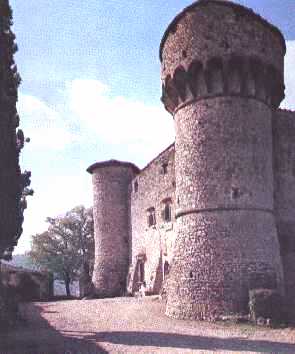

The origin of Meleto was in the 11th century, as a possession of the monks of the nearby Coltibuono Abbey. The first vassal of the castle was said to have been a certain Guardellotto. He was stripped of all his possessions for some emnity with the emperor Federico Barbarossa, who entrusted Meleto to the local family, Firidolfi, already installed in another castle in the area. This is the origin the branch of the Firidolfi known as 'from Meleto' while another division of the family was known as Ricasoli Fibindacci. These family names were strongly tied to the history of Chianti. The strategic position, on a hill led to direct control of the underlying road connecting Valdarno and Chianti. Additionally, its proximity with the border between the territories guarded by the Sienese and Florentines, made this castle the last defense. Meleto was one of the principal fortifications of the Terziere (one of the three parts in which the Florentine military organization was organized) of the 'Chianti League' headed by Gaiole. For this reason the castle was for centuries a theater of war. Luckily, Meleto never suffered serious destruction. The essentially 'military' nature of the installation can still be seen today, despite the transformations made in the 18th century. The shape of irregular quadrate, almost a trapezoid, has its focus at the center of the Keep. Although it has been noticably lowered, it still shows us a classical example of the castle-enclosure.
In 1478 the castle was occupied by the Aragonese army allied with Siena. Two years later it was quickly regained by the Florentines who started great projects of structural reinforcement. The 1480's addition is today practically still intact and consist of the two mighty cylindrical bastionated towers, containing machicolulis (openings between corbels of a parapet through which the defenders can drop rocks or fire projectiles against an enemy directly below them). These are located at the two southern angles (the more exposed). The two bricks walls at the northern angles overlook the edge of the crag, so are already naturally defended. The reinforcement of these walls curtains toward the only access road and there are peep holes and gun holes, partly hidden, along the perimeter of the enclosure. Thanks to this, in 1529, Meleto victoriously withstood the siege of the imperial troops. Never destroyed through disputes, sieges, and battles, the castle was transformed into a villa during the 18th century and its defenses were partly dismantled. The interior is visible by an admission fee. It still has the look of this period, with decorated halls and an original little theater. There are seven original sceneries of a play performed in the year 1742. Meleto remained in the ownership of the Ricasoli family until about thirty years ago and is today the center of an agricultural co-op for wine production. |
Return to Tour 98
